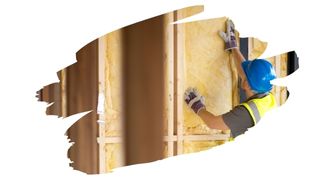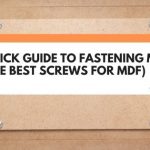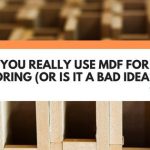Want to soundproof your woodwork shop? But, are you also worried about the high cost of soundproofing materials?
Then you might be surprised to learn that MDF can be used to help soundproof workshop walls. But, exactly how good is MDF at absorbing sound?
Well, in this post, you’ll find out the easiest (and cheapest) materials you can use to soundproof your shop. You’ll also learn what an STC rating is…and why it matters for soundproofing materials.

This post may contain affiliate links to products that we receive a commission for (at no additional cost to you). Learn more here.
What Is The Best Way To Reduce The Noise In My Workshop?
The best way is to try and use less noisy tools.
And yes, this seems like an obvious answer. But, it is an easy (and likely least expensive) solution to a noisy environment.
So swapping power tools for hand tools, will go a long way to minimizing noise levels — helping you to get back on good terms with your neighbors.
You can learn more tips on how to go about this, by checking out our post: Woodworking When You Live In An Apartment (5 Tips)
But, let’s say you have no choice but to use powered tools. In which case, the next best thing you can do is to soundproof the walls of your workshop.
And soundproofing walls typically involves donning walls with sound absorbing materials.
And What Is The Cheapest Way To Soundproof A Room?
You can line the walls with thick materials such as carpets, cushions, and curtains. A combination of materials, (namely combining carpet with cushions), can significantly mute loud noises of up to 85 decibels.
For a little perspective, 75 to 85 decibels is about as loud as people shouting.
Related Post: A Quick Guide To Fastening MDF (+ The Best Screws For MDF)
What About MDF? Does MDF Dampen Sound?
It does, and it’s probably one of the better wood composite materials you can use for soundproofing.
Thanks to it’s thickness and density, MDF is a touch more soundproof than natural solid wood. And this is reflected in MDF’s STC rating.
And What Is An STC Rating?
Well, the STC, (Sound Transmission Class), rating measures how good a material is at absorbing noise. This measure is used in the United States to rate how well walls, doors and windows mute sound.
Now, materials with very high STC levels are fantastic at muting airborne sound. In fact, when it comes to residences, materials that have an STC rating between 38 to 42, are the go-to options.
However, when it comes to recording studios, (where it’s of utmost importance to mute any outside noise), the materials used on those professional booths will have an STC rating of 50-65.
And What About MDF’s STC Rating?
Here’s the thing; while MDF is better at soundproofing than solid wood, it’s not that great at it either.
MDF has an STC rating of 33, which means that it’s not even up to scratch as a residential property soundproofing material.
Solid wood, on the other hand, has an STC rating of around 30-32, (depending on a range of factors, such as wood density).
Related Post: A Quick Guide To MDF Interior Doors (Top 3 Pros And Cons)
So Which Material Is Better For Soundproofing Than MDF?
Typically, fiberglass is the go-to soundproofing insulation material if you want to get serious about reducing sound in your home. And fiberglass has an STC rating of 39.
And remember earlier when we mentioned using a combination of cushions plus carpet, to soundproof your shop? Well, the combination of these two thick materials have a combined STC level of 48.
In other words, using these much cheaper materials would place you within touching distance of professional soundproofing.
So Is MDF Good For Soundproofing My Workshop?
Well, MDF is better than nothing. But, carpet, cushions and heavy rugs, will absorb noise much better than an MDF-lined wall will.
Now, MDF is cheaper than natural solid wood, (or other composite wooden materials such as plywood). And it is certainly way less costly than fiberglass.
However, if you shop around, you can get cut-price rugs and blankets for a fraction of the price of MDF.
To Wrap Up, Here Are The 3 Key Takeaways From This Post…
- 1). MDF, due to its density, can absorb sound and reduce noise levels.
- 2). It is not the best material for soundproofing. It is only slightly more soundproof than solid wood.
- 3). For affordable soundproofing material, line your workshop walls with a combination of thick cushions and carpet. These two materials combined will do a much better job than MDF at soundproofing.
References:
Sound Transmission Class | ScienceDirect.com



